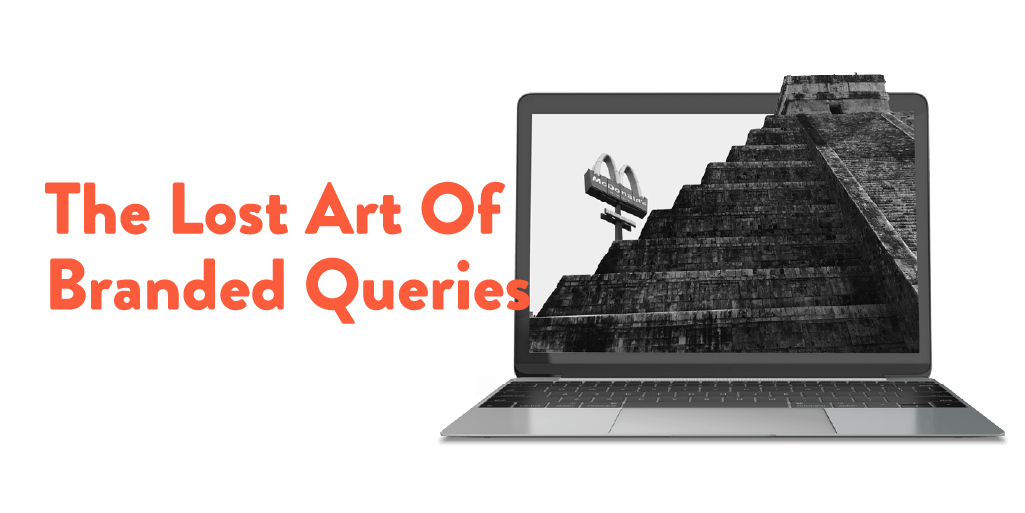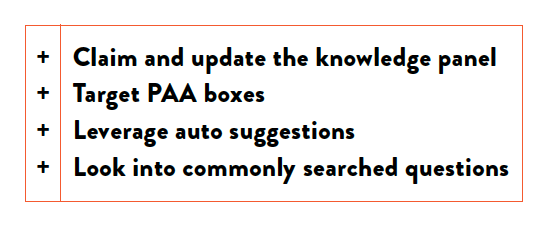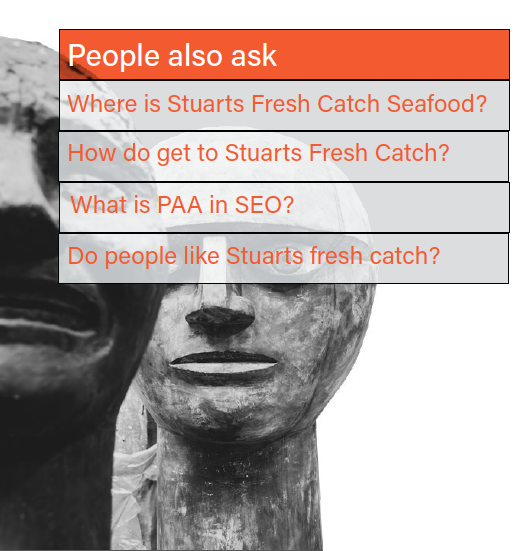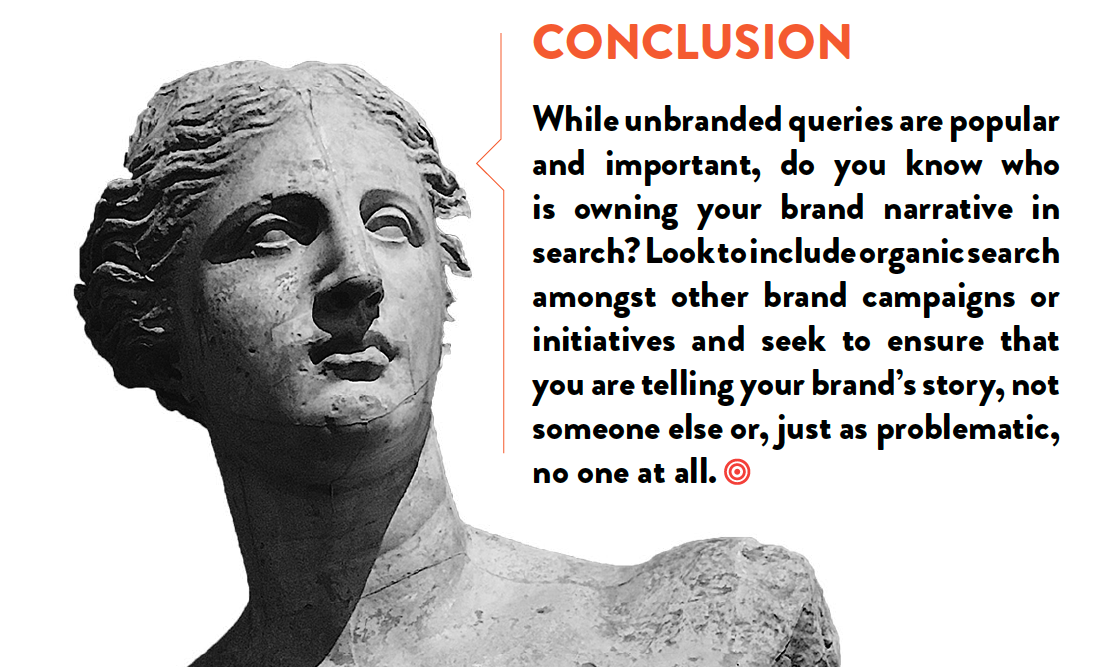
Searches without a brand name, otherwise known as unbranded or non-brand searches, have been on the rise since 2016, according to MomentFeed.[1] Brand searches can refer to the brand name itself; executives at the company, parent companies, or affiliates; initiatives; names of services or products; trademarks; and more.

But even with this consumer shift, we can’t forget about the benefit of owning branded queries.
Thinking about branded terms became a relic in my previous agencies, until I started working on larger brands which focused more on campaigns, leaning heavily into other channels like media and social and brand awareness. When it came to these larger brands, I had to regain confidence that focusing on branded terms was the right space in which to play. It counteracted all the buzzing in the search industry about what to focus on, and data proved there were more unbranded searches than branded. Still, going against the grain proved valuable for my clients, and now I’m challenging us all to think about and optimize for branded search. It’s not just important for the big brands; it’s important for all brands.
Why Focus on Branded Queries?
- Get more qualified traffic that’s closer to conversion, as these searchers are already familiar with your brand and show interest in your product or service.
- Build brand awareness like you would with other channels and pair with other marketing initiatives.
- Uncover insights about your brand from search data to fuel creative campaigns and inform other business or marketing decisions.
- Don’t leave your brand terms up for grabs, allowing for third party sites or competitors to overtake you within the search results.
Think of your branded search engine results page (SERP) as the ‘homepage’ someone lands on before interacting with your owned properties. This is their first impression of your brand before they actually meet you on your website or social media, so it’s imperative to make a great first impression with reliable, current, and on-brand information.
This becomes increasingly important if you’re running campaigns. When a consumer sees or hears your brand name via other channels like digital ads, radio, TV, or social media, they may turn to Google later on, if not right then, to discover more about the brand they encountered earlier.
When you Google your brand, what do you see? A knowledge card with facts and figures? Organic links to your website and paid search ads? What about People Also Ask (PAA) boxes, featured snippets, maps, news stories, or links to social media?
When you see these results, do you own them all? Are those links going back to the digital properties your brand owns, manages, or is a part of? Or, are there other sites, competitors, or third parties answering questions and taking up space about your brand and business? If you aren’t there, someone else will be.
It’s likely you own basics within branded SERPs without much effort. There’s not much of a need to add branded keywords to your content. Your website is there, along with perhaps a knowledge graph with a logo. But what about the details? There’s a multitude of ways to dive in and find opportunities.

Knowledge Panel
Check to see what else can be owned on the Knowledge Graph or if the proper links are pulling in and pointing searchers to the right destination. Claim your knowledge card, if you haven’t already, and be sure to get your social media profiles verified and your social media channels linking back to your main site. To level up, use schema-structured data to markup the social media profile links on your website. If your knowledge panel is inaccurate, make a suggestion with the “Feedback” button within the SERP.
PAA Boxes
Scour the PAAs on your brand name SERPs and see what common questions are being searched about your brand and who is answering. Consider building out FAQ content focusing on these branded questions so that you own the narrative. Remember, you need to have better content and answers than those who are already there. Level up by adding in more FAQ content discovered through customer service teams or community management channels. Don’t forget to use schema-structured data here, too. This type of content can help you earn more PAAs and increase your brand’s footprint within the SERPs.
Autosuggest
Start typing in your brand name in the search bar and see what autosuggestions pop up. Is there anything alarming? Or are there conversations in which you’d like your brand to be a part or the driver of? Go to these SERPs and see what information is present. Are there myths to dispel or outdated and wrong information still winning? This should be a call to action to either create content to beat these results or reach out to the site to provide accurate information.
A great example is recalls. Creating FAQ content around this topic or a hub to support this ever-changing and easily-outdated topic can ensure that you will successfully direct news outlets and search engines there in order to pull the latest information.
Question-based Queries
But what else can branded searches tell us? Aside from SERP digging, question-based brand terms are a gold mine and something we recommend to our clients frequently. Using different tools like Answer the Public, SEMrush or Moz, you can run your brand terms and pull commonly-searched questions. You can uncover themes and perceptions people may have about your brand, simply by analyzing commonly searched questions. This has led us to not only create content to answer and rank in search, but also to address these common questions in social media or even create brand awareness campaigns using this additional information.

Unlike social media, getting brand mentions in search doesn’t trigger a notification. There are no @tags or #hashtags to showcase someone using your brand name on the platform. Instead, track and monitor different variations of your brand name, misspellings, and even other ownable terms, such as products or product lines with a keyword ranking tool or Google Alerts.
Leverage tools like SEMrush or SimilarWeb to see search volume trends. If your spot increases in search volume during different months, is this tied to campaigns you’ve run via other channels? Or is it a result of brand seasonality? These insights can help prioritize when your focus should be on branded vs. unbranded search optimizations.

[1] https://momentfeed.com/blog/the-rise-of-non-branded-search/



